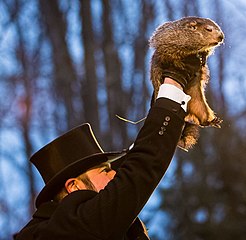
Sunday is Groundhog Day, the day when a large rodent leaves his burrow, looks around, and decides whether or not winter will continue another six weeks. Some folks say the groundhog is correct about 37 percent of the time, though that could be pure luck.
Groundhogs are actually squirrels, commonly known as marmots. Groundhogs are also known as woodchucks, apparently because the Algonquian name for this creature was wuchak.
As a child, the only thing I’d ever heard about woodchucks was the famous tongue-twister:
How much wood could a woodchuck chuck, if a woodchuck could chuck wood?
A woodchuck would chuck all the wood he could, if a woodchuck could chuck wood!

As it turns out, a wildlife biologist did some research to find out how much wood the woodchuck might be able to chuck if it chucked wood. [Sorry about that.] By measuring the volume of dirt in a woodchuck burrow and estimating how much wood could fit into the hole, he concluded a woodchuck could chuck 700 pounds of wood, if it chucked wood, which it doesn’t.
The Why of Groundhog Day
The Pennsylvania Dutch brought the custom of Groundhog Day with them when they migrated from Germany to Pennsylvania. According to legend, if a hibernating animal makes a shadow on February 2, winter will last another 6 weeks.
In 1886 the Punxsutawney Spirit newspaper published the first announcement of Groundhog Day events. Other towns have similar celebrations, but the one in Punxsutawney is the best known, especially after the 1993 movie Groundhog Day.

Today the celebration runs from Jan. 31 through Feb. 2, with as many as 40,000 anxious on-lookers gathering to watch a sleepy groundhog, known as Punxsutawney Phil, get passed around by men in top hats and frock coats.
The Groundhog Club sponsors this curious ritual. According to club lore, there is only one Phil, the one who started making weather predictions in 1887. How can this be, since a wild groundhog usually lives only six years? Glad you asked. Every fall Phil receives ‘groundhog punch’ administered at the annual Groundhog Picnic.
The club’s Inner Circle decides beforehand whether or not Phil will see his shadow. The Vice President prepares two scrolls in advance of the February 2 ritual. One says there will be six more weeks of winter; one predicts an early spring.

The ceremony begins before sunrise. Participants and witnesses make their way to Gobbler’s Knob two miles outside of town where Phil sleeps peacefully in his burrow. At daybreak, Phil’s handler reaches in to wake up the gently snoring groundhog.

Phil then explains to the president whether or not he’s seen his shadow in a language known as Groundhogese that only the club President understands. The President directs the Vice-President to read the appropriate scroll to the anxious crowd. In the video clip from last year’s ceremony, Phil indicates the correct scroll, so there is some variation in communication.
Is Phil Accurate?
The Stormfax Almanac started checking Phil’s projections in 1999. During that time, there were 12 incidents where Phil saw his shadow during inclement or cloudy weather, and one incident where he couldn’t see his shadow in bright sunshine.
But it’s a bit of fun in the middle of winter, as well as a tourism boost for Punxsutawney, Pennsylvania. Here’s a clip from last year’s festivities.
Groundhog Day 2019: Punxsutawney Phil Makes His Weather Prediction. CBS News. Feb. 2, 2019.
Punxsutawney Pennsylvania by Doug Kerr.
Groundhog Standing1 by Erin Silversmith.
Groundhog Day 2005 by Aaron Silvers.
Welcome to Gobblers Knob, Groundhog Day 2005 by Silvers Family.
Punxsutawney Phil, Feb. 18, 2018 by Chris Flook.
Alina Bradford. “Facts About Groundhogs.” Live Science. Feb. 17, 2017.
Michelle Ganney. “Groundhog Day 2019 Facts.” New York Post. Jan. 31, 2019.

Sandra Wagner-Wright holds the doctoral degree in history and taught women’s and global history at the University of Hawai`i. Sandra travels for her research, most recently to Salem, Massachusetts, the setting of her new Salem Stories series. She also enjoys traveling for new experiences. Recent trips include Antarctica and a river cruise on the Rhine from Amsterdam to Basel.
Sandra particularly likes writing about strong women who make a difference. She lives in Hilo, Hawai`i with her family and writes a blog relating to history, travel, and the idiosyncrasies of life.

